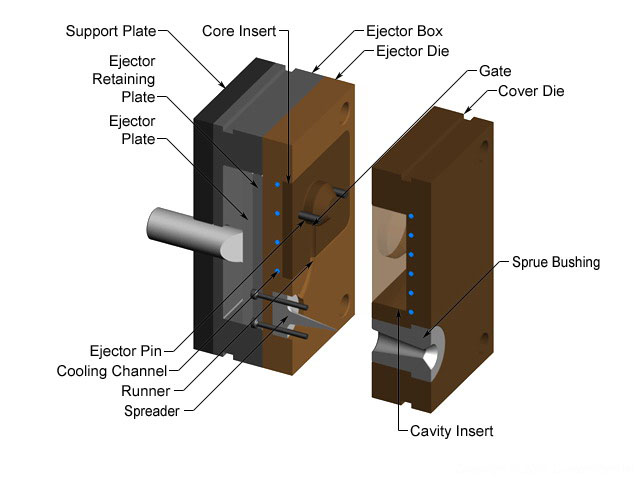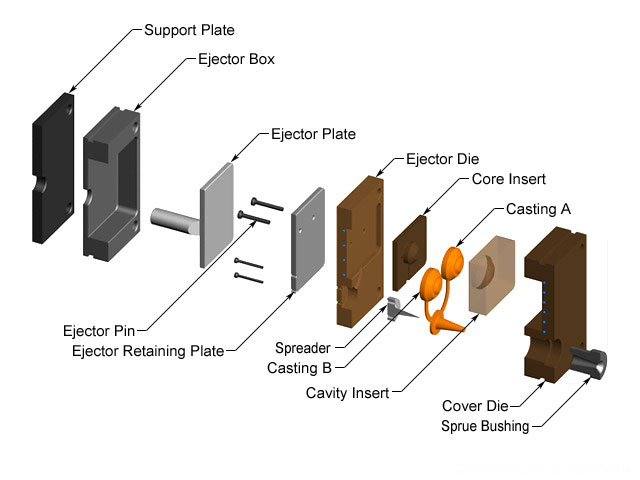The dies into which the molten metal is injected are the custom
tooling used in this process. The dies are typically composed of
two halves - the cover die, which is mounted onto a stationary
platen, and the ejector die, which is mounted onto a movable
platen. This design allows the die to open and close along its
parting line. Once closed, the two die halves form an internal
part cavity which is filled with the molten metal to form the
casting. This cavity is formed by two inserts, the cavity insert
and the core insert, which are inserted into the cover die and
ejector die, respectively. The cover die allows the molten metal
to flow from the injection system, through an opening, and into
the part cavity. The ejector die includes a support plate and
the ejector box, which is mounted onto the platen and inside
contains the ejection system. When the clamping unit separates
the die halves, the clamping bar pushes the ejector plate
forward inside the ejector box which pushes the ejector pins
into the molded part, ejecting it from the core insert.
Multiple-cavity dies are sometimes used, in which the two die
halves form several identical part cavities.
Die channels
The flow of molten metal into the part cavity requires several
channels that are integrated into the die and differs slightly
for a hot chamber machine and a cold chamber machine. In a hot
chamber machine, the molten metal enters the die through a piece
called a sprue bushing (in the cover die) and flows around the
sprue spreader (in the ejector die). The sprue refers to this
primary channel of molten metal entering the die. In a cold
chamber machine, the molten metal enters through an injection
sleeve. After entering the die, in either type of machine, the
molten metal flows through a series of runners and enters the
part cavities through gates, which direct the flow. Often, the
cavities will contain extra space called overflow wells, which
provide an additional source of molten metal during
solidification. When the casting cools, the molten metal will
shrink and additional material is needed. Lastly, small channels
are included that run from the cavity to the exterior of the
die. These channels act as venting holes to allow air to escape
the die cavity. The molten metal that flows through all of these
channels will solidify attached to the casting and must be
separated from the part after it is ejected. One type of channel
that does not fill with material is a cooling channel. These
channels allow water or oil to flow through the die, adjacent to
the cavity, and remove heat from the die.
 
Die
assembly – Open (Hot chamber) Die assembly – Opened (Cold chamber)
 
Die assembly - Closed (Hot chamber) Die assembly - Closed (Cold chamber)
 
Die
assembly - Exploded view (Hot chamber) Die assembly - Exploded view (Cold chamber)
Die Design
In addition to these many types of channels, there are other
design issues that must be considered in the design of the dies.
Firstly, the die must allow the molten metal to flow easily into
all of the cavities. Equally important is the removal of the
solidified casting from the die, so a draft angle must be
applied to the walls of the part cavity. The design of the die
must also accommodate any complex features on the part, such as
undercuts, which will require additional die pieces. Most of
these devices slide into the part cavity through the side of the
die, and are therefore known as slides, or side-actions. The
most common type of side-action is a side-core which enables an
external undercut to be molded. Another important aspect of
designing the dies is selecting the material. Dies can be
fabricated out of many different types of metals. High grade
tool steel is the most common and is typically used for
100-150,000 cycles. However, steels with low carbon content are
more resistant to cracking and can be used for 1,000,000 cycles.
Other common materials for dies include chromium, molybdenum,
nickel alloys, tungsten, and vanadium. Any side-cores that are
used in the dies can also be made out of these materials.
HOME PAGE | CASTING BLOG | CONTACT US |

